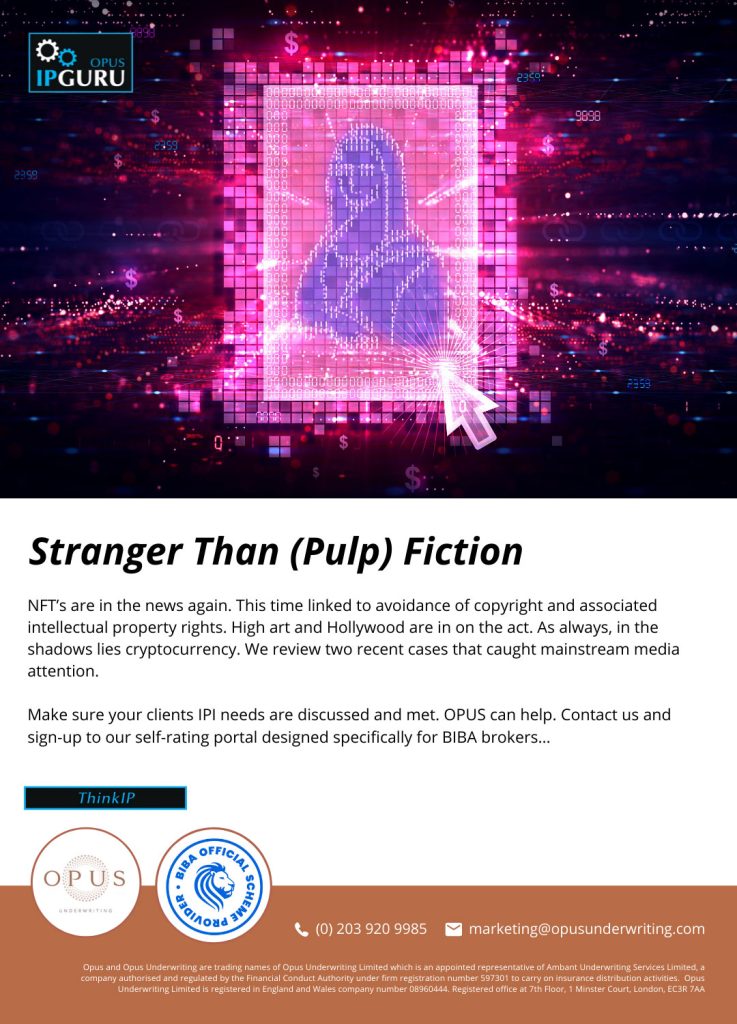Cutting Edge Technology
It’s almost as if Edward Scissorhands himself has just entered the art market. Well, sort of. Such is the current predilection in some quarters for chopping ‘art’ into tiny pieces and selling it on for not so tiny profit. All enabled by the coming of age of NFT’s or “Niftys” (see July 1,2021, “Too Shifty to be Nifty”) converging nicely with next generation cryptocurrencies and crypto trading platforms. The stars are aligned. By “stars” we mean those of a celebrity rather than celestial nature. As jumping on bandwagons go, there’s a bit of a queue and it’s not particularly orderly as the laws of intellectual property play catch-up to make sense of it all.
We’ll have a go for you.
All the way to the Banksy
Let’s start in the art market, with a Banksy, obviously.
In December last year The Sunday Times reported a former prominent auction house executive had teamed up with cryptocurrency experts to buy a painting called “Love is in the Air”. The one depicting the hurling of flowers instead of a grenade. An iconic Banksy image and very popular. Pricey mind you at $12.9m. But there was the plan to monetise it.
Jig-saw puzzle
Divide that picture into 10,000 squares and sell them off as NFT’s for $1,500 each and bank yourself a couple of million dollars for all that sweaty graft. Each NFT being a chunk of code associated with the hacked-up image, recorded on blockchain to form digital certificates of authenticity. How romantic.
For the art-loving buyers every square
“…represents a minority ownership in the painting and it will come with its own collector’s card that shows the whole artwork as well as the [square’s] location on the painting.”
Both considerate and time saving. Nice.
Individuals behind this enterprise see it as enabling those interested in art“…to be part of it” and via the NFT (even though the image of the original is everywhere)it’s only you that owns a piece of it. Only you can say, “it’s mine” in this “…new narrative of owning things.”
If the project is successful, its backers see this being rolled out across fine art master pieces. But Banksy isn’t such a piece, so why start there? As you might expect they have an answer for that. This Banksy image has a rebellious spirit which is an apt metaphor for challenging the art market status quo. Cynics might add, so too is Dick Turpin.
Once Upon a Time in Hollywood
Next up, Quentin Tarantino. Yes, he of Pulp Fiction and other film favourites. He’s had the scissors out too in pursuit of gold. Here’s his proposed gig.
Having sat on the original handwritten script for some 28 years he would now like to flog it and cash in. In bits, chapter by chapter, in a cryptocurrency auction via nonfungible NFT’s. To funk it up and make it even more irresistible, each chapter will contain an audio commentary from Tarantino himself to ensure,
“…the collector who purchases one of these limited-edition rare NFT’s will be the first to look into the mind and unique creative process of Quentin Tarantino”
…so says the auction site tasked with getting this product ‘away’. Oh, and buyers must have a Meta Mask wallet and Ethereum or other cryptocurrency to make such a purchase. “Natch”.
Problem is Miramax bought all the intellectual property rights to Pulp Fiction in the early 1990’s.
Reservoir Dogs
“Are you gonna bark all day, li’l doggie, or are you gonna bite?”
Miramax are inclined to bite to protect what they bought. But here’s the thing. When they bought the copyright, trademarks and associated marketing rights in the 90’s, cryptocurrency didn’t exist, nor did NFT’s. So, Miramax is left with a quandary. If they chase Tarantino, it requires IP law to stretch out and prohibit his ambition and it will test an IP acquisition contract drafted way before tech such as NFT’s existed or were contemplated. Miramax could fail, Tarantino could prevail Django-like, free himself, and set a legal precedent for intellectual property rights.
At the core of these ‘NFT for sale’ examples, is an attempt to thwart conventional ownership and copyright principles. New technology does this. It has a habit of disrupting all around it including the law. It’s fair to say IP lawyers and entertainment executives are carefully watching this dispute play out because so many other similar arguments over NFT’s and IP rights embedded in old contracts are likely to follow.
According to Thomas C. Danziger a specialist lawyer in art and related transactions,
“This is the tip of the iceberg…every third call I get is about NFT’s”
Lawyers are pawing over old film rights contracts asking themselves are,
“…the words used in contracts …broad enough”[Alan Behr of Phillips Nizer LLP]
Here’s another curiosity thrown up by NFT’s. Miramax are both in effect and reality, suing Tarantino over content they will never see. They are in the dark, holding the meagre contract-clause candlelight of knowledge, that says they own the rights to Pulp Fiction and the discarded material. It might not be enough.
Desperado
Big profits through the sale of NFT’s is, evidently, just too tempting for some. Celebrities now trying their luck should stay off one particular bandwagon, that of climate change. NFT’s and the technology they embrace require colossal amounts of computing power that is very bad for the climate and, thereby, one’s image. It is also highly questionable whether NFT’s genuinely open the art market to newcomers. The ‘old’ art market could not be more diverse for those with the curiosity and wit to learn how to enter it. Despite the current hype around NFT’s very few people are making a lot of money with them. Mr. Tarantino’s auction, if successful and further unchallenged, might turn that on its head.
Perhaps the child’s cry in Hans Christian Andersen’s tale of The Emperor’s New Clothes sums up current NFT hesitancy,
“But he hasn’t got anything on!”
Murray Fairclough
Development Underwriter
OPUS Underwriting Limited
+44 (0) 203 920 9985
underwriting@opusunderwriting.com
Researched by Ben Fairclough








